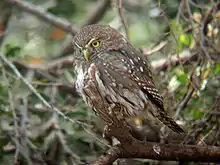| Austral pygmy owl | |
|---|---|
.jpg.webp) | |
| Scientific classification | |
| Domain: | Eukaryota |
| Kingdom: | Animalia |
| Phylum: | Chordata |
| Class: | Aves |
| Order: | Strigiformes |
| Family: | Strigidae |
| Genus: | Glaucidium |
| Species: | G. nana |
| Binomial name | |
| Glaucidium nana (King, 1827) | |
 | |
| Distribution of austral pygmy owl Resident | |
The austral pygmy owl (Glaucidium nana) is a species of owl in the family Strigidae. It is found in Argentina and Chile.[3]
Taxonomy and systematics
_-_Torres_del_Paine_National_Park_17.jpg.webp)
The austral pygmy owl has sometimes been treated as a subspecies of ferruginous pygmy owl (Glaucidium brasilianum) but DNA studies and other data support its being a species in its own right. It is monotypic.[4][5]

Description
The austral pygmy owl is 17 to 21 cm (6.7 to 8.3 in) long. Males weigh 56 to 75 g (2.0 to 2.6 oz) and females 70 to 100 g (2.5 to 3.5 oz). It has gray-brown and red morphs and intergrades between them. Adults of both morphs have a pale grayish brown face with dark flecks, whitish "brows" over pale yellow eyes, and black "false eyes" on the nape. The gray-brown morph's upperparts are dark grayish brown with whitish dots of variable size and shape. The tail is also dark grayish brown with narrow buffy bars. The throat is white, the sides of the upper breast dark grayish brown, and the underparts off-white with dark grayish brown streaks. The red morph has a similar pattern but reddish brown replaces the dark grayish brown.[5]
Distribution and habitat
The austral pygmy owl is found from approximately Valparaíso Province in Chile and Neuquén Province in western Argentina south to the tip of Tierra del Fuego. In Chile it ranges in elevation from sea level to 2,000 m (6,600 ft). It inhabits a variety of landscapes from city parks and farmland with scattered trees to deciduous forests and thickets, evergreen shrublands, temperate and southern beech (Nothofagus) forests, and Patagonian scrub/steppe.[5]
Behavior
Feeding
The austral pygmy owl is primarily diurnal but is also active at night. It is a solitary hunter that sallies from perches to capture insects, birds, mammals, and reptiles. It has been documented taking birds almost double its own weight.[5]
Breeding
The austral pygmy owl usually nests in a tree cavity but has also been documented using holes in earthen banks. They lay a clutch of three to five eggs between September and November, and the female alone incubates them.[5]
Vocalization
The austral pygmy owl has five primary vocalizations. Pairs maintain contact with "a whistle with 6 to 7 notes/sec described as huj-huj-huj-huj-huj-huj". Their territorial call is "a sharp trill described as truie-truie-yi-yi". Nestlings make "soft metallic chirps trigigigirrr or trigigick". Both sexes make a courtship call, "a whistle...described as tiririi-tiririi, and an undefined call rendered as diud or diuh".[5]
Status
The IUCN has assessed the austral pygmy owl as being of Least Concern.[1] Though its population has not been quantified, the species is "reported to be the most abundant owl in Chile".[5] In agricultural areas it is persecuted because its nocturnal calls are interpreted as an ill omen.[6]
References
- 1 2 BirdLife International (2016). "Austral Pygmy-owl Glaucidium mooreorum". IUCN Red List of Threatened Species. 2016. Retrieved September 6, 2021.
- ↑ "Appendices | CITES". cites.org. Retrieved January 14, 2022.
- ↑ Gill, F.; Donsker, D.; Rasmussen, P. (July 2021). "IOC World Bird List (v 11.2)". Retrieved July 14, 2021.
- ↑ Remsen, J. V., Jr., J. I. Areta, E. Bonaccorso, S. Claramunt, A. Jaramillo, D. F. Lane, J. F. Pacheco, M. B. Robbins, F. G. Stiles, and K. J. Zimmer. Version 24 August 2021. A classification of the bird species of South America. American Ornithological Society. https://www.museum.lsu.edu/~Remsen/SACCBaseline.htm retrieved August 24, 2021
- 1 2 3 4 5 6 7 Norambuena, H. V. (2020). Austral Pygmy-Owl (Glaucidium nana), version 1.0. In Birds of the World (T. S. Schulenberg, Editor). Cornell Lab of Ornithology, Ithaca, NY, USA. https://doi.org/10.2173/bow.aupowl1.01 retrieved September 6, 2021
- ↑ Jiménez, Jaime (1989). "Biology of the Austral Pygmy-Owl". The Wilson Bulletin. 101 (3): 377–389. JSTOR 4162747.
External links
- Austral Pygmy Owl videos on the Internet Bird Collection
- Stamps (for Chile) with RangeMap
- Austral Pygmy Owl photo gallery VIREO Photo-High Res
- Photo-Medium Res; Article prba.com
